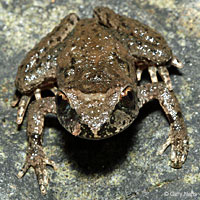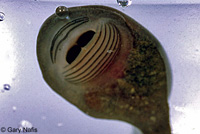|
 |
 |
 |
| |
Adult, Del Norte County |
|
 |
 |
|
|
Adult, Del Norte County |
Adult, Pacific County, Washington |
 |
 |
|
Male, showing the tail-like copulatory organ. |
Adults in amplexus, Multnomah Co., Oregon © 2000 Brad Moon |
 |
|
 |
Underside of the head of a tadpole, Del Norte County (The mouth is on the bottom of the head.) |
Tadpole feeding at night (underwater)
Del Norte County, showing the
white spot on the tail tip. |
|
 |
 |
 |
Metamorph which has not yet absorbed its tail, Del Norte County © Alan Barron |
Vertical pupil |
 |
 |
|
Habitat, Mendocino County |
Habitat, Del Norte County |
Habitat, Del Norte County |
More pictures of this frog and its habitat from the Northwest can be seen here.
|
|
Description |
| Size |
| 1-2 inches in length (2.5 - 5.1 cm). |
| Appearance |
| A flat, toadlike frog with fairly rough skin. Coloring matches the colors of rocks around the stream inhabited - usually olive, brown, gray, or reddish above with yellow and gray mottling, a pale yellow or greenish triangle on the snout and a dark eye stripe. The pupil is vertical. The fingertips are hardened like claws to help the frog crawl among rocks on stream bottoms. Lungs are reduced to decrease buoyancy, and respiration takes place through the skin. |
| Voice |
| Apparently this frog does not vocalize, most likely due to the noisy stream environment it inhabits. |
| Behavior |
| Adult are usually active from April to October, depending on the locality. This frog is a stream-dweller, inhabiting moist stream banks. In drier conditions, it can be found under rocks near streams. They do not inhabit ponds or lakes. In wetter conditions, they may disperse away from the stream. A rocky streambed is necessary for cover for adults, eggs, and larvae. |
| Diet |
| Most likely eats a wide variety of invertebrates. |
| Reproduction |
| Ascaphus is the only genus of frogs which fertilizes internally through copulation. The Tailed Frog is named for the tail-like copulatory organ possessed by males of the species. Breeding apparently occurs in early fall. Eggs are laid in June and July, hatching in August and September. Tadpoles are black or brown with a white spot on the tip of a long tail, and a large sucker-like mouth, which they use to cling to rocks in streams. Tadpoles can be observed at night foraging on rocks. Metamorphosis takes from one to four years, with more time needed in montane populations. |
| Range |
| Ranges from near Anchor Bay, Mendocino county, north along the coast and east to near Big Bend, Shasta County, and north to the Oregon border. Ranges farther north through the Cascades Mountains of Oregon and Washington and along the north coast of British Columbia almost to Alaska. |
| Habitat |
| Inhabits cold, clear, rocky streams in wet forests. Occasionally, in areas without trees. (According to Stebbins, A. truei quickly established itself on treeless terrain created by the eruption of Mt. St. Helens in Washington.) From near sea level to 8400 ft. (2560 m.) |
| Taxonomic Notes |
| Two species of Ascaphus, A. truei, and A. montanus, the Rocky Mountain Tailed Frog, are now recognized. |
| Conservation Issues (Conservation Status) |
| Tailed Frog populations may be severely reduced as a result of the sedimentation and warming of streams caused by timber harvesting and road building. |
|
|
Taxonomy |
| Family |
Ascaphidae |
Tailed Frogs |
| Genus |
Ascaphus |
Tailed Frog |
| Species |
truei |
Coastal Tailed Frog
|
|
Original Description |
Stejneger, 1899 Tailed Frog
from Original Description Citations for the Reptiles and Amphibians of North America © Ellin Beltz
|
|
Meaning of the Scientific Name |
Ascaphus: - Greek: a - without, and Greek: skaphis spade - notes the lack of a metatarsal spade
truei: - honors True, Frederick W.
from Scientific and Common Names of the Reptiles and Amphibians of North America - Explained © Ellin Beltz
|
|
Alternate Names |
Western Tailed Frog
Tailed Frog
|
|
Related or Similar California Frogs |
Rana boylii - Foothill Yellow-legged Frog
Rana aurora - Northern Red-legged Frog
Ascaphus montanus - Rocky Mountain Tailed Frog
|
|
More Information and References |
Natureserve Explorer
California Dept. of Fish and Game
AmphibiaWeb
Stebbins, Robert C. A Field Guide to Western Reptiles and Amphibians. 3rd Edition. Houghton Mifflin Company, 2003.
Behler, John L., & F. Wayne King. The Audubon Society Field Guide to North American Reptiles and Amphibians. Alfred A. Knopf, 1992.
Corkran, Charlotte & Chris Thoms. Amphibians of Oregon, Washington, and British Columbia. Lone Pine Publishing, 1996.
Jones, Lawrence L. C. , William P. Leonard, Deanna H. Olson, editors. Amphibians of the Pacific Northwest. Seattle Audubon Society, 2005.
Leonard et. al. Amphibians of Washington and Oregon. Seattle Audubon Society, 1993.
Nussbaum, R. A., E. D. Brodie Jr., and R. M. Storm. Amphibians and Reptiles of the Pacific Northwest. Moscow, Idaho: University Press of Idaho, 1983.
Bartlett, R. D. & Patricia P. Bartlett. Guide and Reference to the Amphibians of Western North America (North of Mexico) and Hawaii. University Press of Florida, 2009.
Elliott, Lang, Carl Gerhardt, and Carlos Davidson. Frogs and Toads of North America, a Comprehensive Guide to their Identification, Behavior, and Calls. Houghton Mifflin Harcourt, 2009.
Lannoo, Michael (Editor). Amphibian Declines: The Conservation Status of United States Species. University of California Press, June 2005.
Wright, Anna. Handbook of Frogs and Toads of the United States and Canada. Cornell University Press, 1949.
|
|
|
The following status listings come from the Special Animals List which is published several times each year by the California Department of Fish and Game.
|
Organization
|
Status Listing
|
| U.S. Endangered Species Act (ESA) |
None |
|
| California Endangered Species Act (CESA) |
None |
None |
| California Department of Fish and Game |
DFG:SSC |
California Species of Special Concern |
| Bureau of Land Management |
|
|
| USDA Forest Service |
|
|
| Natureserve Global Conservation Status Ranks |
G4 S2S3 |
Apparently Secure |
World Conservation Union - IUCN Red List
|
IUCN:LC |
Least Concern |
|
|



















